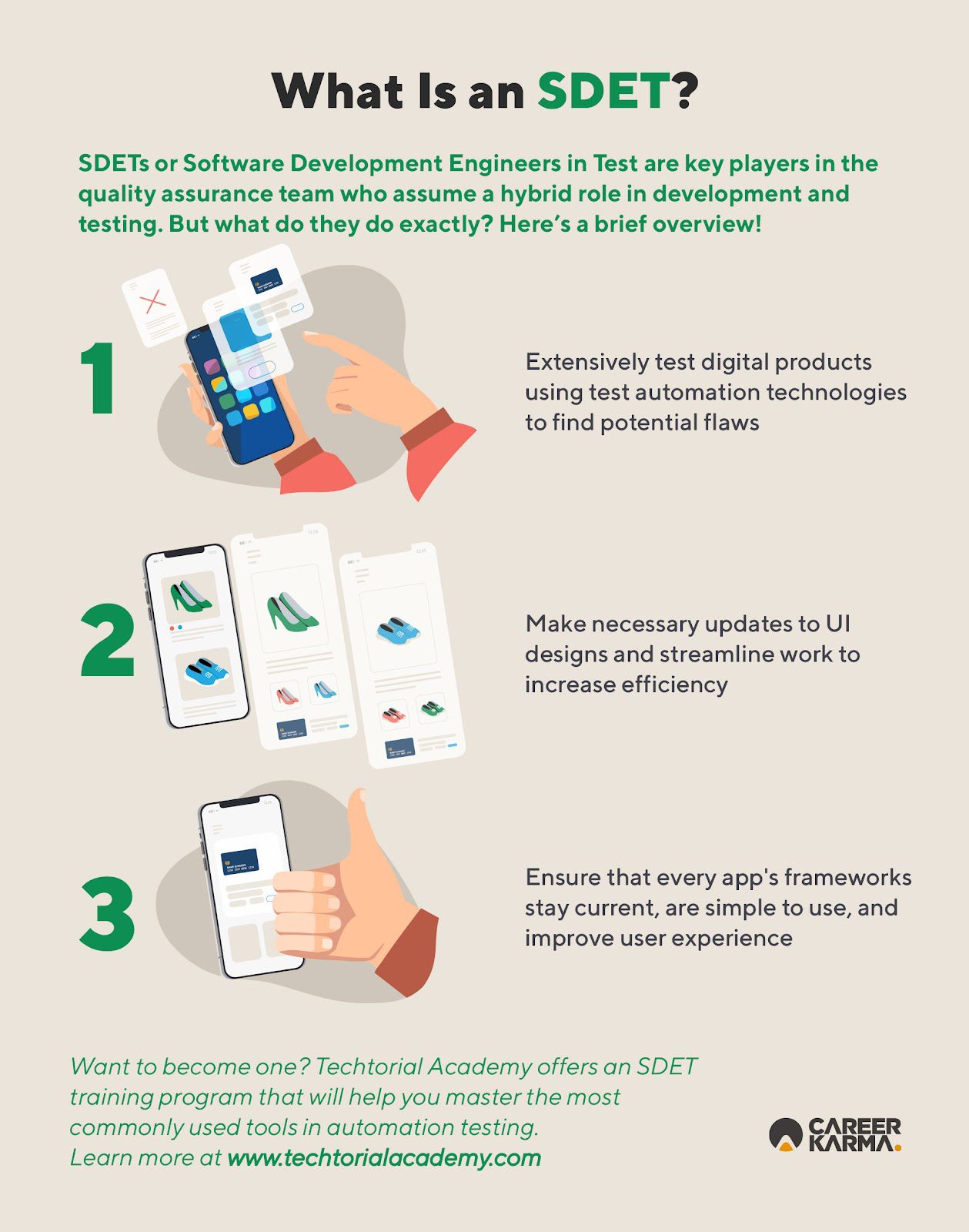Nowadays, it seems impossible to go about your daily activities without using a mobile app or software. We rely on digital tools for just about anything, like entertainment, health, finances, and even managing our work. It makes one wonder how these tools run smoothly, considering the number of users on a system at any given time.
Well, this can be accomplished with the help of SDETs or Software Development Engineers in Test.
You may have heard about software developers and testers who build and launch functional apps and programs from scratch. In this article, we’ll talk about SDETs, who have the combined skills of both, but with a more specialized role.
But first, if you’re wondering why SDETs deserve the spotlight, it’s because they are becoming increasingly popular as business leaders realize how crucial SDETs are in maintaining the quality of their digital products. A quick search on LinkedIn shows about 280,000 Test Engineer opportunities in the United States alone waiting to be filled. And you have a chance to land one of them.
Ready to hop on the career train and get a job as an SDET? Read how Techtorial Academy can get you there.
What Is an SDET?

An SDET or a Software Development Engineer in Test is a key player in the QA or quality assurance team. They guarantee that digital products meet the requirements and needs of consumers. With them in place, companies are more confident that they can yield a higher end-user satisfaction rate.
However, the SDET role is much more complex than that. Below are the main responsibilities of an SDET:
- Conducting software development and testing tasks. At this stage, SDETs put digital products through the wringer with several test automation tools to determine any errors or defects. Doing so allows them to identify areas for enhancement and pinpoint user experience issues, whether in design or coding.
- Maintaining test automation frameworks. Software engineers and QA professionals rely heavily on test automation frameworks, like the Selenium framework, to check the quality of digital products. These tools and guidelines help the development team work faster and more efficiently, too. SDETs are responsible for test management, updating UI designs when necessary, and simplifying tasks to reduce time.
- Reviewing framework designs. Testing processes applied to products evolve. SDETs ensure that the frameworks for each app are up to date, easy to use, and provide a better user experience.
Such responsibilities require aspiring SDETs to possess an analytical mind, be excellent collaborators and have proven organization and time management skills. Does this sound like a perfect career for you? If yes, then an SDET career may be ideal for you!
Techtorial Academy boasts an 88 percent job placement rate, bridging graduates to exciting SDET (Software Development Engineering in Test) roles. If they can do it, so can you!
Learn more about the program.Reviewing Techtorial Academy’s SDET Course

Techtorial Academy is a bootcamp you must consider if you want to build a solid foundation before starting an IT career. Among Techtorial Academy’s top programs is a 24-week SDET course, boasting a rigorous and immersive learning experience for IT novices and career shifters.
According to founder David Turan, what sets Techtorial Academy’s SDET course apart from other bootcamps is its inclusion of tools and programming languages widely used across different industries. The skills and knowledge you gain are what hiring managers are looking for, making you a more competitive candidate. These tools include Java, Selenium, and Cucumber, among others.
Java Programming Language
Java is one of the most fundamental programming languages used by IT professionals across the globe. It is used in backend and full stack application development, big data engineering, and cloud-based application development.
Because of its versatility and scalability, mastering Java is an excellent addition to your tech stack, allowing you to run automated testing in conjunction with other testing tools. Students who complete the course are also given a Java OCA certification.
What You’ll Learn
During the SDET course, you will learn about Java operators, Java APIs, Java methods, Java constructors, and the Java collection framework.
Selenium
Selenium is a commonly used open-source framework that can be utilized for web application automation testing to produce test scripts. It is a vital tool that checks web browsers and platforms for bugs, performance, and responsiveness.
What You’ll Learn
Delving deeper into the Selenium framework, you will be taught about the Selenium Webdriver, Selenium Grid, and AWS.
Cucumber BDD
Cucumber Behavior Driven Development (BDD) is a “business readable” framework. Complex codes and functionalities are simplified and translated into English, allowing non-tech professionals to understand technical problems and solutions. In effect, the Cucumber BDD is instrumental in creating a more collaborative workspace across different departments.
What You’ll Learn
During this part of the course, you will learn how to create and run feature files, use a scenario outline, apply a Cucumber hook, and create a Cucumber HTML report.
Other tools you will encounter during the course include TestNG, SQL, and API testing using Rest-Assured and Postman. Beginner-friendly classes are taught by proficient instructors who have significant experience working in the IT field. Students get to pick their brains filled with invaluable knowledge, best practices, and tried-and-tested tips from the real world.
The bootcamp also focuses on enriching the career knowledge of its students, preparing them for the job hunt. During the course, you will be taught what to expect from interviews and how to respond to common questions through mock interviews. You can count on your career coach to develop your soft skills and professional brand, increasing your chances of getting hired.
How Much Does the SDET Course Cost?
Techtorial Academy students have the option to pay $10,000 up front. But the bootcamp also offers flexible payment options.
For students enrolled in the on-campus SDET Course, you can pay a $1,000 monthly fee to be paid within six months, and the remainder shall be settled after landing a job. The online SDET Course is also structured similarly with a $1,000 monthly fee for five months and a balance of $4,000 to be paid upon employment.
Finally, Techtorial Academy also provides lower monthly fees at $500. At the end of the course, you will have to settle a balance of $8,000. While this is pricier than the other options, it allows you time to gather your funds as you complete the course.
Where Can an SDET Career Take You?
The SDET career path can be an exciting opportunity for those seeking growth, especially at a time when the demand for digital products is at an all-time high. Suddenly, companies are finding themselves always chasing after the ever-changing consumer needs.
SDETs play a crucial role in developing digital products we love in a sprint, making it a thriving career for years to come. Techtorial Academy can bring you closer to exciting opportunities, as evidenced by its 88 percent job placement rate. Among the companies that trust Techtorial Academy grads include Facebook, Walgreens, and Bank of America.
You can land entry-level roles like junior SDET, where you can learn the ropes of the discipline and earn an annual average salary of $87,128. In comparison, SDET Techtorial Academy grads reportedly take home about $90,000— a competitive entry-level annual salary plus perks. With four years of experience, you can start managing your team as an SDET manager and further advance to tech architect.
Learn with confidence and launch your career as an SDET with the help of Techtorial Academy. Enroll now!
About us: Career Karma is a platform designed to help job seekers find, research, and connect with job training programs to advance their careers. Learn about the CK publication.




